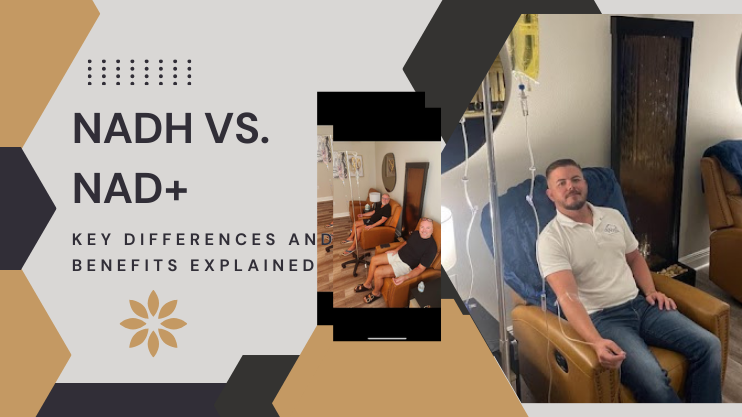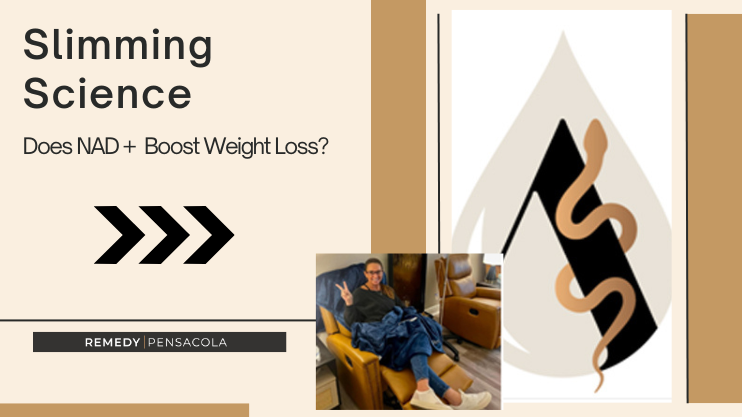NAD or Nicotinamide Adenine Dinucleotide is an essential coenzyme that participates in metabolic processes. It is responsible for cellular processes such as ATP generation, cell aging, epigenesis, and much more. Studies have suggested that a decrease in NAD+ is related to fastening in the aging process and overall energy levels.
While you may have heard about NAD therapy, you may have come across the abbreviation NADH. However, what is NAD+ and How is it different from NADH?
Learn about nadh vs nad+ and how NAD therapy helps to boost your mechanism and overall health.
What is NAD Plus?
NAD or Nicotinamide dinucleotide is a bioenzyme that is made up of your body’s cells. It binds to essential proteins and fuels the metabolism with ATP generation. Mitochondria is the major organelle which is responsible for ATP generation. Decay of this mitochondria or decline of NAD can result in early signs of aging.
NAD is essential as it works on the mitochondria. Our cells contain a centered organelle called the nucleus which harbors chromosomes. These chromosomes contain the genetic units called genes. There are various parts marked on these chromosomes. The end parts called telomers are responsible for aging. As the telomeres get shorter, the aging of chromosomes increases.
NAD is believed to work on the proteins at these specific sites and reduce the reduction process by having positive effects on the DNA repair mechanism.
What is NADH?
NADH stands for Nicotinamide Adenine Dinucleotide + Hydrogen. In this case, NAD has accepted hydrogen thereby getting this name.
It is important to understand that a process goes around that causes the oxidation of NAD to form NAD+ and its reduction to form NADH.
But, What is the oxidation and reduction process and why is it important to know about this process?
Learn about the Oxidation And Reduction Process
In a chemical reaction, oxidation refers to the loss of electrons, which means NAD+ is less on electrons and can accept electrons to form NADH. On the other hand, NADH has excess electrons and it can undergo reduction to form NAD+.
Let us understand this process by a simple explanation:
NAD+ enters mitochondria, the cell organelle present in all cells. NADH is already present inside the mitochondria, and if you remember it has access to electrons so it can donate some of it to the newly entered NAD+ to form NADH. As NADH itself donates its electrons it becomes NAD+.
Here, NAD+ is the oxidized form as it is less on electrons and can accept electrons from other molecules. NAD therapy is therefore given so that NAD+ can enter the cells, bind with electrons to form NADH, and participate in various biological processes. You may be surprised to know that NAD+ and NADH are different forms or states of NAD.
NADH on the other hand, is the reduced form as it has accepted two electrons (from two hydrogen atoms) and has completed the oxidation-reduction process.
NAD Therapy
Now that you understand the scientific difference between these two forms, let us explore learning about NAD therapy. Studies suggest that when this catalytic cycle stops functioning well, the levels of NAD decline. This decline is linked to many neurodegenerative problems including a decrease in energy levels and aging.
NAD therapy involves enriching one’s system with NAD infusions that increase the NAD levels in your body.
It is important to note that, our body produces energy through the transfer of electrons. NAD plays a vital role in this same process of oxidation and reduction that you have read above. Sometimes, these electrons remain unpaired and give rise to molecules called free radicals which can cause the cells to undergo oxidative stress. A surplus of NAD is therefore necessary to ensure your cells are healthy.
Benefits Of NAD Therapy
Enhancing Mental Function: One of the most significant benefits of this therapy is its effect on the brain. According to research, it has a good influence on brain functioning, mood, depression reduction, memory regeneration, and neurological function development. It has also been linked to reduced brain fog and exhaustion.
Furthermore, NAD therapy is a promising method of addiction treatment. Substance addiction causes the brain to seek more and more drugs, resulting in withdrawal symptoms if the individual stops using them. In these situations, NAD links to neurotransmitters, reducing desires and facilitating a speedy recovery process.
Boosting strength: NAD treatment has also been demonstrated to improve performance by reducing pain and inflammation. NAD+ treatment is commonly recommended for athletes looking to gradually raise their metabolic levels and improve their performance.
An anti-aging tool- its effects are mostly related to the regeneration of damaged cells. NAD treatment replenishes the body’s NAD+ levels, which may have decreased with aging. They are also linked to improved sleep patterns since circadian rhythms and mitochondria are intrinsically related. As age is a key contributor to a reduction in the circadian cycle’s correct activity, this coenzyme ensures proper binding and restores sleep cycles to normal.
Which one should you try Oral NAD or IV NAD?
The major difference is the mode of administration of NAD. As the terms suggest, Oral NAD is taken via oral supplements that are absorbed through the cells in the digestive tract. From your gut, it is absorbed in the blood. However, as it takes a longer route to reach your bloodstream, some of the NADs can be lost on the way due to gut absorption rates and other processes.
Someone looking to increase their NADs swiftly can try IV therapy wherein NAD is directly injected into the the circulation through intravenous or intramuscular administration.
Final Note
Once you’ve scheduled an appointment, your clinician will check your vitals to make sure your heart rate, breathing rate, and blood pressure are all within normal ranges. They will also consider your medical history and dietary intake before recommending a dose depending on your age and other factors. The session can last for an hour or can go up to three hours depending on the dose prescribed to you. Book an appointment today to know the best session for you.




